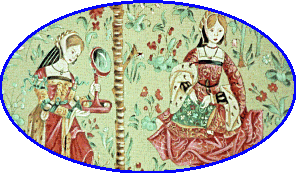

... the most charming of the symbols. Symbol of fidelity and ingeniousness on the one hand and of the clever and the female spirit on the other hand. It is agreed, since old times, while speaking about the embroidery on canvas to name it "needle-worked tapestry", canvaswork or "needlepoint". The " Petit Point" was traditionally the favorite pastime of the Ladies of peerage and gentry of Ancient Regime and still today by actual royal or highness families, and the Middle-class of XIXth century. These aristocratic persons could express using Petit Point with threads of wools or silk and even threads of noble metal like gold and silver, and, from the drawing on their canvas all the nuances of their hearts. Today, it is yet very in vogue: Its facility of execution, the diversity of the stitches, its use and the variety of its destination in the traditional and modern style life, in luxury and fine decorations, undoubtedly explain its success. It can be besides to also see in the grace which accompanies necessarily the gesture to paint with wool a good reason for the attraction that still the needlepoint tapestry keep nowadays.
Among most famous and most eclectic, let us quote in XVIIIth century: Jean Pillement who was an at the same time acquarellist, landscape designer and French engraver and which we can admire works in the
majority of the museums of the large French cities. Also Jean-Baptiste 0udry French painter and engraver, who ensured the direction of the Manufacture de Beauvais and in same time the surinspection of the one
of Gobelins.
The artists of XXth century also bring their talent to the art of the tapestry. Two the most famous are
Jean Lurçat & Jean Picart le Doux.
"Cartonnier",Jean Lurçat was initially a painter influenced by Cézanne. One owes him, as a cartonnier,
If Lurçat were initially a painter, like much of cartonniers, Picart le Doux were initially a bookbinder and an engraver. It is its meeting with Lurçat which lead him to be interested as from
1940 in the tapestry. One owes him "the Man and the thought", exposed to the Faculty of Arts of Caen.
They both formed many pupils and disciples. Among them one can quote Jean-Claude Duprez, with whom we owe to the tapestry "Cock and Music" (published by DMC®). (*)

